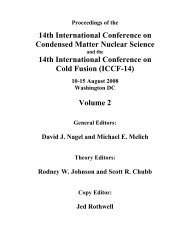Transmutation of metal at low energy in a confined ... - LENR-CANR
Transmutation of metal at low energy in a confined ... - LENR-CANR
Transmutation of metal at low energy in a confined ... - LENR-CANR
Create successful ePaper yourself
Turn your PDF publications into a flip-book with our unique Google optimized e-Paper software.
Fig. 3. Electrochemical Plasma Cell<br />
3. Electrochemical Plasma Cell work<strong>in</strong>g conditions.<br />
Applic<strong>at</strong>ion <strong>of</strong> the voltage causes H+ to migr<strong>at</strong>e to the c<strong>at</strong>hode (the electrode th<strong>at</strong> is <strong>at</strong> neg<strong>at</strong>ive<br />
potential) and OH- to migr<strong>at</strong>e to the anode (the electrode <strong>at</strong> a positive potential). This ionic flux<br />
al<strong>low</strong>s current to pass through the cell and produces hydrogen <strong>at</strong> the c<strong>at</strong>hode and oxygen <strong>at</strong> the<br />
anode. The oxygen is produced through the ionic OH- discharge <strong>at</strong> the anode, and the hydrogen<br />
ma<strong>in</strong>ly through the direct discharge <strong>of</strong> the w<strong>at</strong>er molecule <strong>at</strong> the c<strong>at</strong>hode, fol<strong>low</strong><strong>in</strong>g the reactions:<br />
C<strong>at</strong>hode: 2H2O + 2e - = H2 + 2OH - or 2H3O + + 2e - → H2 + 2H2O<br />
Anode : 4OH - = 2 H2O + 4e- + O2<br />
The overall c<strong>at</strong>hode reaction is strongly enhanced by the electrolytic. For example, the potassium<br />
ions (K+) th<strong>at</strong> are dissolved <strong>in</strong> the solution have a gre<strong>at</strong>er oxid<strong>at</strong>ion potential than hydrogen. The<br />
c<strong>at</strong>hode reaction will last until all the hydrogen disappears from the solution. Simultaneously, the<br />
potassium ions will condense around the c<strong>at</strong>hode, without deposit<strong>in</strong>g on it, thereby gener<strong>at</strong><strong>in</strong>g a<br />
screen with a positive potential th<strong>at</strong> holds itself a few nm from the electrode. This peculiar<br />
configur<strong>at</strong>ion is similar to a c<strong>at</strong>hode condenser <strong>in</strong> which the positive electrode is cre<strong>at</strong>ed by the<br />
potassium ions and the neg<strong>at</strong>ive electrode is the c<strong>at</strong>hode itself. In this situ<strong>at</strong>ion, the dielectric is the<br />
double layer consist<strong>in</strong>g <strong>of</strong> H3O + and H2 loc<strong>at</strong>ed between the two electrodes. In spite <strong>of</strong> this screen <strong>of</strong><br />
potassium ions, ions <strong>of</strong> the hydrogen, be<strong>in</strong>g much smaller, will cont<strong>in</strong>ue to discharge on the c<strong>at</strong>hode<br />
without difficulty and gener<strong>at</strong>e gaseous hydrogen. (Hydrogen ions are so small, they are practically<br />
protons, <strong>in</strong> some ways.)












